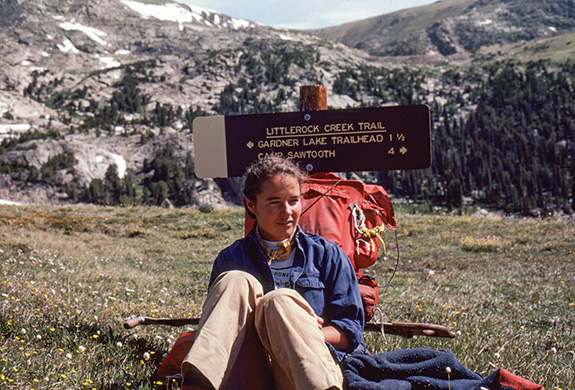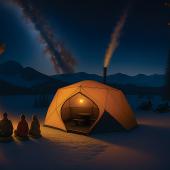Call of the Wild
As the final segment of our four-part series, Outside Bozeman caught up with Greater Yellowstone Coalition’s former executive director, Caroline Byrd, for a conversation exploring the intersection of recreation and conservation—and how the former nurtured her passion for the latter. When not advocating for the health of the ecosystem, Caroline can be found hiking, watching wildlife, or earning her turns in the mountains bordering Yellowstone Park.
O/B: At what point did you decide to pursue a career in conservation?
CB: I think from birth! Being outdoors was always a driving force for me. I really solidified that when I went away to college and did a bunch of different field quarters—one of which was coming to the Northern Rockies and studying bighorn sheep. I just had that lightbulb moment where I realized that this was home and that this was where I wanted to live and work. Since then, I’ve spent my career in the outdoors and in conservation.
O/B: How did outdoor recreation influence your career decision?
CB: I spent my 20s and 30s outdoors—in the wilderness. I started my career as a seasonal worker for the Forest Service on a trail crew and as a wilderness ranger in the Shoshone National Forest, just east of Yellowstone. Then, I was a NOLS [National Outdoor Leadership School] instructor for 15 years and I spent a lot of my life tromping around the wild lands of the Northern Rockies, Alaska, the Southwest, Canada, the North Cascades, and East Africa.
I was really fortunate to have a career in the outdoors—climbing big mountains, doing all kinds of really tremendous outdoor adventures, as well having the privilege of teaching people outdoor skills and teaching about conservation and leadership. It was a really fabulous opportunity and fed my commitment and passion for conservation.

Caroline circa 1983
O/B: What is one of your distinct, early outdoor recreation memories?
CB: I grew up in California and my family often went camping. For my 13th birthday, I decided that I wanted to go backpacking. That’s not something my family did, but I got together with some friends and we hiked across Yosemite from the east side to the west side.
For me, that was the epiphany of “you can do this.” That was the moment that I decided that this was what I wanted to do. This was a place that felt right to me. Growing up in Los Angeles, that was not normal. None of my peers had that same passion. The Sierras, for me as a kid, were a shrine. I felt inspired and couldn’t wait to spend more time in the mountains.
O/B: What is your proudest recreation achievement?
CB: Through NOLS, and with my great friends, I was able to climb Denali a couple of times. We climbed the Northwest Buttress back in 1989. It was a remote route on the mountain and it took us a long time. Climbing Denali was just an unbelievable experience—the wildest of the wild. When you’re on the Northwest Buttress you’re looking down the Wickersham Wall and you’re looking north for countless miles of wild, wild country.
Climbing Denali’s Northwest Buttress was a pivotal experience for me since I was the only woman and I ended up being the first woman to climb that route.
O/B: Where do you see conservation and recreation coming together?
CB: Recreation is one of the key ways we spend time outside and we get huge benefits from being outdoors. There is no question that being outdoors richens our lives and gives us a sense of how important the outdoors and wild lands are.

Caroline says: grin and bear it
O/B: How do you propose balancing recreation pressure with conservation goals in the Northern Rockies?
CB: I truly believe that we need a new ethic. I’m old enough that I have seen Leave No Trace start and take hold. Now, we need a Leave No Trace 2.0 and we need an understanding and ethic around knowing our impact. Knowing when, where and how we recreate is important. We need to have an understanding of the impact our recreation might be having on wildlife, on water quality, and on vegetation.
I would never say we shouldn’t recreate but I think there needs to be an enhanced awareness of what we’re doing, where we’re doing it, how we’re doing it and, if it has an impact, making a choice to not do it. That way, we know that our recreational activities are not harming the places that we hold so dear and love so much.
O/B: Where do you see the greatest challenges between conservation and recreation?
CB: I think that the challenge is how we balance recreation and conservation so that we’re recreating in a way that enhances the outdoors rather than takes away from it.
O/B: What is your most gratifying conservation accomplishment?
CB: The most recent one is helping pass the Yellowstone Gateway Protection Act that stopped two (potentially) really damaging gold mines. It was a community coming together in a way that was just unbelievably powerful. It really affirmed that conservation is not partisan. All of us that live in this part of the world care deeply about this place and will do what needs to be done in order to protect it.
O/B: If you could ask one request of the Bozeman’s recreation community in regards to your conservation goals, what would it be?
CB: Recreate! Enjoy, but know where you’re going, what wildlife lives there, what they’re doing while you’re there and how your recreational activity might impact them. Increase your awareness of what your impact may be and make your choices accordingly.













